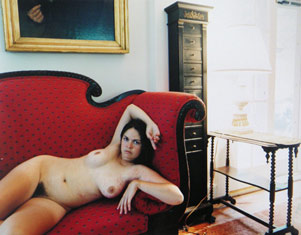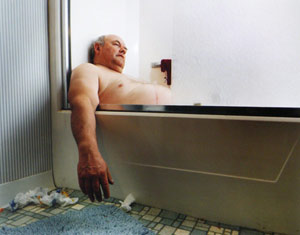Tracey Baran

About the Exhibition
Tracey Baran (United States, born 1975) creates visual journals, using color photography to record and refine her experiences into images that reference fundamental themes such as love, death, and regeneration. Rarely preconceiving her pictures, Baran works in an intuitive manner, casting her photographer’s eye on the world until something sticks. Thus a photograph can occur at any moment, in any place, in a practice that starts with instinct and results in the communication of very universal experiences.
Baran’s pictures capture the simple elegance of color in the most ordinary corners of everyday life. In this regard her photography is allied to that of William Eggleston, renowned for its exaltation of prosaic subject matter and its mastery of the interplay between light and color. Like Eggleston, Baran is fluent in the expressive capacity of color photography and she often counterbalances the formal beauty of her pictures with a certain unsettling ambiguity.
For example, Baran’s man in a bathtub is captured in a state of deadened sensibility; void of obvious emotion, his expression hovering between restful and catatonic, between life and death. The picture is suggestive of a murder scene such as Jacques-Louis David’s The Death of Marat (1793), but unlike David’s record of an act completed, Baran’s narrative is inconclusive. Gritty details of degeneration disturb the quiet intimacy of the scene: the scar on the man’s bulging belly and the mold, grime, and trash on the bathroom tiles instill a sense of general weariness and inevitable decay.
In fact, the man is Baran’s father, and her depiction of him is disarmingly ambivalent. The picture is from Still (2001), a series of photographs Baran made in and around the small towns of upstate New York where she grew up, but in which autobiography is not the primary concern. Instead, using symbols of life and death, Baran links disparate subjects such as pig carcasses piled next to concrete slabs in a lush forest, or a nude self-portrait in which her ivory skin is covered with a poison ivy rash. These images from an affective meditation on duration and the cyclical nature of life. In a strategy akin to that of Sally Mann, Baran explores mortality as witnessed in blemished human bodies and the landscape that for her constitutes home.
All of Baran’s photographs evidence an insistent process of visual discovery. In her series Give and Take (1999), Baran charted the beginning of her relationship with her boyfriend. However, she sought to evoke not the couple’s particularity so much as the basic themes of attraction, vulnerability, and reproduction. These elegant but dissimilar scenes include grass blanketed by downy cottonwood seeds, Baran sitting with her back towards us, hunched over in a gynecologist’s office, and a cat contemplating his kill – a small mouse lying dead on the concrete. As metaphors for the progression of a relationship and its attendant pleasures, torments, and risks, Baran’s photographs form an enthralling survey of power dynamics and the biology of love.
Through a process of careful extraction and editing, Baran creates lyrical images that invite open interpretation. Her photographs function with a cumulative intensity. Like a written diary, in which each entry is better understood upon reading further, the true spirit of Baran’s photographs is discovered when they are considered as a part of the whole. Each photograph informs the others and in that interplay of images, their meaning fluctuates and expands.
-Karen Irvine, Associate Curator
Image Gallery

